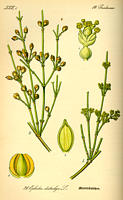Gnetales
Luerss. 1879
Common names
Gnetophytes.
Taxonomic notes
The gnetophytes have been treated as separate from other seed plants at the ranks of division (Gnetophyta Bessey 1907), subdivision (Gnetophytina Cronquist, Takht. & Zimmerm. ex Reveal 1996), class (Gnetopsida Thom 1886), subclass (Gnetidae Cronquist, Takht. & Zimmerm. ex Reveal 1996) and order (Gnetales Luerss. 1879). Since the gnetophytes consist of only 3 families and 3 genera, they are here treated with combined descriptions of each family and genus:
For long, Gnetophytes were thought to represent a sort of primitive angiosperm. Superficially they resemble angiosperms more than gymnosperms, and some authors even suggested that they represented a derived group of angiosperms. A molecular biology study of Gnetum gnemon (Winter et al. 1999), however, suggested that conifers and gnetophytes are sister groups, and that the evolution of flower-like reproductive structures may have occurred independently in gnetophytes and angiosperms. An independent study of chloroplast DNA from several angiosperm, gymnosperm and gnetophyte taxa (Samigullin et al. 1999) reached a similar conclusion, and subsequent studies have progressively confirmed this interpretation while also showing that the Gnetum+Welwitschia clade is sister to Ephedra (Stevens 2010 and references therein).
Description
I have yet to prepare a proper description of the gnetophytes. See Stevens (2010) for a highly technical description.
Distribution and Ecology
The three Gnetophyte genera have largely disjunct distributions. Ephedra occurs mostly in semiarid and arid parts of North America, Mexico, South America (Ecuador to Patagonia and lowland Argentina), S Europe, Asia, and N Africa (including the Canary Islands) (Stevenson 1993). The other genera are exclusively tropical: Welwitschia in Africa: Angola and Namibia, and Gnetum in wet forests of Indo-Malaysia, tropical parts of West Africa, Fiji and the northern regions of South America (Schultes & Raffauf 1990).
Almost all gymnosperms form a vesicular-arbuscular mycorrhiza, but species in the Gnetales and the Pinaceae form ectomycorrhizas (Brundrett 2008).
Remarkable Specimens
The largest sizes are probably found in Gnetum gnemon, and the greatest ages in Welwitschia mirabilis.
Ethnobotany
There is limited use of Gnetum and extensive pharmacological use of Ephedra; see the genus descriptions for details.
Dendrochronological studies are not recorded in the Gnetales. Most species of Gnetum are vines and thus are probably unsuitable, although the small tree Gnetum gnemon may have potential. Species of Ephedra have rings that are presumably annual and there may be potential to recover useful information, such as oxygen isotope variation, from the rings of this species. Welwitschia does not form rings.
Remarks
Citations
Brundrett, Mark. 2008. Mycorrhizal Associations: The Web Resource. mycorrhizas.info, accessed 2009.06.09.
Dumortier, B.C.J. 1829. Analyse des familles des plantes, avec l'indication des principaux genres qui s'y rattachent Tournay: J. Casterman aîné. P. 11. Available at the Biodiversity Heritage Library.
Martius, C.F.P. von. 1835. Conspectus Regni Vegetabilis: Secundum Characteres Morphologicos Praesertim Carpicos in Classes Ordines et Famillas Digesti, p. 11.
Prantl, K.A.E. 1894. Lehrbuch der Botanik für mittlere und höhere Lehrenstalten ed. 9:203.
Reveal, J.L. 1993. New ordinal names for extant vascular plants. Phytologia 74(3):173-177. Available at the Biodiversity Heritage Library.
Samigullin, T.K.; Martin, W.F.; Troitsky, A.V.; Antonov, A.S. 1999. Molecular data from the chloroplast rpoC1 gene suggest a deep and distinct dichotomy of contemporary spermatophytes into two monophyla: gymnosperms (including Gnetales) and angiosperms. Journal of Molecular Evolution 49(3):310-315.
Stevens, P.F. 2010. Angiosperm Phylogeny Website: Gnetales. www.mobot.org/MOBOT/Research/APweb/orders/gnetales.html, accessed 2010.02.11.
Stöber, Kurt. 1999. Images from Thomé, Flora von Deutschland etc. http://www.mpiz-koeln.mpg.de/~stueber/thome/index.html, accessed 2003.05.01, now defunct.
Winter, K.U.; Becker, A.; Munster, T.; Kim, J.T.; Saedler, H.; Theissen, G. 1999. MADS-box genes reveal that gnetophytes are more closely related to conifers than to flowering plants. Proceedings of the National Academy of Sciences 96(13):7342-7347. Available: www.pnas.org/cgi/content/full/96/13/7342, accessed 2006.03.21.
See also
Carlquist, S. 1996. Wood, bark, and stem anatomy of Gnetales: A summary. International Journal of Plant Sciences 157 (6, Suppl.): S58-S76.
Crane, P. R. 1996. The fossil history of the Gnetales. International Journal of Plant Sciences 157(6, Suppl.): S50-S57.
Donoghue, Michael. 1996. Gnetales. Version 01 January 1996 (temporary). http://tolweb.org/Gnetales/20645/1996.01.01 in The Tree of Life Web Project, http://tolweb.org (accessed 2006.03.21).
Doyle, J. A. 1996. Seed plant phylogeny and the relationships of Gnetales. International Journal of Plant Sciences 157(6, Suppl.): S3-S39.
Endress, P. K. 1996. Structure and function of female and bisexual organ complexes in Gnetales. International Journal of Plant Sciences 157(6, Suppl.): S113-S125.
Friedman, W.E. (Ed.) 1996. Biology and evolution of the Gnetales. International Journal of Plant Sciences 157 (No. 6, Supplement): S1-S125.
Friedman, W. E. and J. S. Carmichael. 1996. Double fertilization in Gnetales: Implications for understanding reproductive diversification among seed plants. International Journal of Plant Sciences 157 (6, Suppl.): S77-S94.
Hufford, L. 1996. The morphology and evolution of male reproductive structures of Gnetales. International Journal of Plant Sciences 157 (6, Suppl.): S95-S112.
Hult, C. D. and P. R. Crane. 1988. The Gnetales: botanical remnants from the age of dinosaurs. Field Mus. Nat. Hist. Bull. 59:21-29.
Martens, P. 1971. Les Gnetophytes (Handbuch der Pflanzenanatomie, Band 12, Teil 2). Gebrueder Borntraeger, Berlin.
Meeuse, A. D. J. 1986. Again: Double fertilization and the mono- versus pleiophyletic evolution of angiosperms. Phytomorphology 36:17-21.
Mundry, M. and T. Stutzel. 2004. Morphogenesis of the reproductive shoots of Welwitschia mirabilis and Ephedra distachya (Gnetales), and its evolutionary implications. Organisms Diversity & Evolution 4(1-2):91-108.
Price, R. A. 1996. Systematics of the Gnetales: a review of morphological and molecular evidence. International Journal of Plant Sciences 157(6, Suppl.): S40-S49.
Rydin, C., K. R. Pedersen, and E. M. Friis. 2004. On the evolutionary history of Ephedra: Cretaceous fossils and extant molecules. Proceedings of the National Academy of Sciences. Available: http://www.pnas.org/cgi/content/full/101/47/16571, accessed 2006.03.21.


